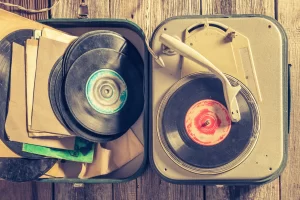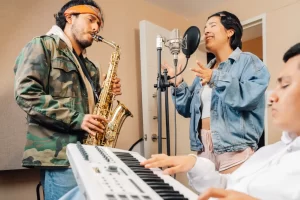EDM (electronic dance music) is longer just the latest fad in the music industry.
From underground dance music to the chart-topping electronic music masters like Tiesto and Calvin Harris, EDM has proven itself to be one of the most popular music genres of all time.
Because of EDM’s explosion in popularity, there’s now an endless list of sub-genres as well. And while there are a variety of high-tech tools and technology that you can use to create your electronic beats, it still requires dedication to learning the craft.
Beginning your EDM journey may feel daunting at first. Even if you created a few tracks, there’s still a lot to learn about becoming an EDM producer. In fact, you might not be sure which steps you need to take.
That’s the reason why we wrote this EDM guide. To help you learn how to mix music and create popping EDM tracks.
Let’s get to it!
EDM Music Concepts You Need to Know
Getting into EDM is always about capturing a feeling. But there are a lot of technical aspects you need to know before you can create the vibe you want for your audience.
The good news is that there are only three distinct actions you need to follow to start making your own tracks: creation, arrangement and refinement.
Creation
Let’s say you’re getting ready to cook dinner. The first step is gathering all of the ingredients that you’ll need. Maybe you dice up some onions, sauté peppers, and marinate some chicken.
This is the creation phase of preparing your dinner.
When it comes to creating EDM, it’s about creating your core ideas. The main ingredients are melodies, vocal hooks, drums, chord progression, etc.
Think about every element you’d need to craft the perfect “recipe” for your track. Gather them all up and prepare to put them together.
Most importantly, don’t be afraid to experiment. Trial-and-error is every artist’s best friend. Fear of sounding bad only holds you back.
You aren’t going to be sharing your first tracks with anyone, and that’s okay. Embrace this stage as a learning period for your ears only.
Arrangement
After you prep your ingredients, it’s time to bring them together and start cooking. This is the arrangement phase. You’re putting everything together, transforming them from stand-alone ingredients into something bigger than its parts.
When you’re arranging EDM, the beats, vocals, and melodies all have to flow in a specific way. They need to meld together and create one palatable piece of cohesive music. Even the most chaotic EDM lovers need something with structure.
In other words, arrangement is the process of making sense of your music. All the core components are there, and now you’re getting them just right.
You’ll sprinkle a little extra bass here, a dash of synthesizer there, until you have a complete track.
Here are a few pointers to keep in mind as you learn how to make EDM music:
- Most EDM beats range between 126-130 beats per minute
- When it comes to drums, your kicks should pop on every quarter note and the snares on every other quarter note
- Simple rhythms should be at the core of every song to avoid sounding too overwhelming
- Use the space between sounds to structure melodies that are rhythmic and entrancing
Refinement
You know that presentation is everything, right? So, just like serving the meal you just made, you want to make sure that it’s appealing. You arrange it on the plate just right but may be add garnishments to make it pop.
It has to be Insta-worthy the minute you slide it onto the table.
The same holds true when you create EDM.
Once you combine all of the key elements, you need to perfect it. Maybe you make edits so that the music flows better, or maybe you’ll have to adjust the sounds so none of them are too loud or too quiet.
As you work on refining your tracks, focus on compression first. This is what helps equalize high and low sounds; it helps make your audio sound clear and get rid of the “fuzziness” a lot of new artists often struggle with.
When it comes to vocals, focus on reverb. This will help amplify your voice and help it fill out the track more but be careful — too much will make the music drown it out.
Lastly, you need to use EQ to highlight the best parts of your music and tune out the worst ones. EQ is all about adjusting frequencies in a track until it achieves the perfect balance.
Now that we’ve covered the core concepts, it’s time to get into what you need to make the magic happen.
Equipment
Obviously, you need the right tool and equipment to produce EDM. And while you could run out and spend thousands, it’s really not necessary. Especially if you’re just starting out, you need a basic setup that lets you mix music while you perfect your tunes.
Computer
When EDM first hit the music scene, production was a time-consuming, not to mention probably uber expensive task given all the equipment that was required.
Thankfully, we’ve come a long way since then. Now, it’s possible to create EDM with only a few carefully chosen pieces of equipment.
You need to think of your computer as the main character in your EDM journey. You can put a variety of sounds together using the DAW and then export the finished track as a mp3 or wav.
Headphones
If you’re serious about making EDM, you need to invest in a pair of high-quality headphones. While they’re an investment, quality headphones eliminate the need for studio monitors and acoustic treatment. They also cancel background noise, which makes mixing your music a lot easier.
MIDI Keyboards
If you already play the piano, then you may want to invest in a MIDI keyboard. However, even if you’re new to the game, you still should get a keyboard that you can practice on.
And don‘t worry if you really know what you’re doing. It’s definitely easier to experiment and learn on a keyboard than it is to learn how to program the MIDI notes into a DAW.
Trust us, we know…
Audio Interfaces
The audio interface lets you record directly into your digital workstation (DAW). You can invest in a more expensive one, which allows for higher inputs and outputs, However, unless you’re planning on recording a lot of vocals, a standard-priced audio interface works just as well.
DAW
The key to becoming an EDM producer lies in learning how to use your DAW. The more DAWs you can master, the better your skills will become. Your digital audio workstation is a key instrument for recording, editing and producing your music.
Some of the most popular DAWS include Cakewalk, Pro Tools, Ableton Live and Reaper. You can also use other types of software to create your EDM tracks, like effect plugins and synth libraries.
DAWs also support devices, like your MIDI keyboard, which streamlines the EDM process. There are tons of online tutorials to help you learn how to use it, so you should check them out if you’re new to the game.
Tips For Creating Your First EDM Track
Once you have all of your gear ready, it’s time to start making music.
1. Start with a classic EDM beat
EDM beats are pretty simplistic. They’re about 126 to 130 bpm (beats per minute), with highs (kicks) on quarter notes, snares on every other note, and percussion with hi-hats to add character and depth.
Keep in mind that simple beats are better because they draw a larger audience of listeners who want to groove to your music. Overly complicated mixes may result in listeners jumping ship. If you’re more of a melodically driven creator, adding intense drum tracks may take up way too much space.
2. Master DAW’s Music Notation Function
Even if you’ve had formal training and are knowledgeable about musical notation, using a gridded timeline to draw notes in by hand can take your composing to the next level. When you first start drawing, don’t worry about the synth sound; simply add the notes and start arranging them into different combinations that sound good.
3. Shift From Templates to Your Own Beats
Top EDM creators never settle for run-of-the-mill plugins. Instead, they learn the principles of how to use synthesized sounds and then flesh out their own.
To get started, buy an inexpensive synth and twist the knobs. Once you get a feel for what each one does, you’ll eventually be able to build your own sonic library.
It’s completely fine to start off with templates, but as you get more comfortable mixing sounds, you’ll want to compose your own from scratch. This will add an originality to your compositions that make them stand out and truly capture your personality as an artist.
4. Embrace Envelope Filters
Creating EDM does require specialized skills, including knowing how to use envelope filters. Briefly, envelopes are meant to shape sound over time.
Typically, envelopes control the volume of a sound or how it’s affected by a filter, starting from the initial note starting point to the end. The fundamental functions of an envelope are the attack, decay and subsequent release.
If the envelope is affecting volume, the attack function will determine how long it will take for the sound peak at full volume.
The decay function determines how long it takes for the volume to start fading. The release function determines the time it will take for sound to go completely silent. When grouped together, these functions are known as ADR.
5. Fall Into the Full-frequency Spectrum
Decide which part of the harmonic spectrum you want to include from each instrument. For instance, maybe you want to add bass resonance or top-end shimmer. Focus on those components and lower the rest of the frequencies so you have room for additional sounds. Also, don’t neglect the extremes. Using a sub-bass boost creates a powerful mix whereas a high-pass filter can clean up a muddy mix.
6. Make Your Own Music Theory
Even though you don’t have to be a Berkeley graduate to create EDM, you do need to formulate a process that works for you. Making music is all about experimenting with different sounds and tones until you find a mix that you love.
Get creative with sounds and melodies, but don’t be too hard on yourself. Simply start making music, save the clips and keep going.
7. Let Inspiration Shape Your Sound
You could spend hours searching online on the best ways to make EDM, however, sometimes it’s better to just go with the flow. If you love the sound of something, keep tweaking it until you’re satisfied.
Look to your favorite EDM creators for inspiration, and use them as reference points throughout the creative process.
You can scour the internet for mixing tips and for secrets of stereo imaging or the mastering process, but sometimes you just have to trust your own ears. Seek out your favorite artists and use them as reference tracks for your own work.
When you’re ready to get your music out into the world, make distribution easier with Novecore. Our platform simplifies the distribution, so you can focus on what matters most: making killer tunes.




